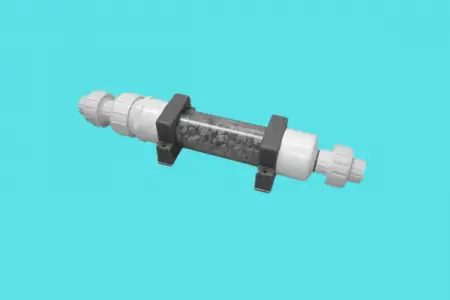Something that most people don’t realize is that the condensation coming out of their furnace, water heater, or boiler is actually acidic. It’s not dangerous to the point of burning your skin or anything like that, but condensation can actually cause damage to your drain and condensation pipes. That’s where a condensate neutralizer comes into play.
A condensate neutralizer is a condensation kit that raises the pH level of condensation to make it safe for your drain pipes. Because condensation from appliances like water heaters is acidic, a condensate neutralizer is sometimes needed to make the water less acidic. This is done to prevent the acidic water from damaging your drainage system.
In this article, we’re going to look at what exactly a condensate neutralizer does and why they’re so necessary. Not everyone needs one of these handy devices, but they can prove to be a lifesaver in certain circumstances. If you have trouble with your condensate lines or drainpipes, then a condensate neutralizer might be just the thing that you need.
How does a condensate neutralizer work?
A condensate neutralizer works by raising the pH level in your condensate water, thereby lowering its acidity. Furnaces, boilers, and water heaters all produce condensation. Because this condensation gets expelled from your home via the same drain pipes as that of your sinks, showers, and toilets, you don’t want any damage to come to your drain pipes.
The acidity of condensation isn’t enough to hurt you if you touch it, but over time it can cause your drain pipes to leak. A leaky drainpipe, especially when it’s underground and difficult to get to, is a homeowner’s worst nightmare. Depending on the type of appliance that you have, a condensate neutralizer might be necessary to reduce the acidity level of your condensation.
Appliances that create condensation should all have a condensate drain attached to them. Condensate drains will be a series of ½ inch or ¾ inch PVC or similar pipe that is connected to your appliance at one end, and run to a floor drain or condensate pump on the other end.
Your condensate neutralizer should be installed somewhere between the appliance and where the drain ends. As the water flows out of the appliance and through the neutralizer, it gets mixed with media. Media is a powdery or gravelly substance inside the neutralizer that raises the pH level of water flowing through it.
When the water exits the other end of the neutralizer, it’s no longer acidic enough to cause any danger to your drain pipes or the rest of the condensation drain.
How often should you change condensate neutralizer?
A condensate neutralizer should last just as long or nearly as long as the appliance it’s connected to. A furnace should last anywhere from 10 to 20 years, a water heater should last about the same amount of time, and a boiler should last around the same amount of time, but might only go for 15 years before needing replacement.
The thing you have to worry about maintaining with a condensate neutralizer is the media doing the neutralizing. As a general rule of thumb, you should check the media once or twice a year and replace it if necessary. The more acidic your water is, the more often the media will need to be replaced.
Another factor that determines how long your condensate neutralizer media lasts is the quality of the media itself. While rudimentary media such as limestone was once the media of choice, the condensate neutralizer industry has come a long way. If you have the option, then pH power pellets specifically designed for neutralizers are the preferred option. They’ll last longer, and be more effective at reducing the acidity of your condensation.
Looking for a DIY option for your condensate neutralizer? Check out this article.
How do I test my water’s acidity?
Testing the acidity of your water is done by using a pH paper test, or a pH digital meter. Both tests will do the same thing, but the digital meter will be slightly more accurate.
pH paper test
Using a pH paper test is relatively simple and straightforward. Simply turn the water on and hold the pH paper underneath it for a few seconds. There’s a color scale that will show how acidic your water is. You can also fill a cup or other container with the water you want to test and insert the pH paper strip into the container. Remove it after a few seconds and the color of the strip will tell you how acidic the water is. Each test strip can only be used one time.
Digital pH meter
A digital pH meter will do the same thing as a pH paper test, but they’re more accurate and easier to read. You’ll want to fill a cup with the water you want to test and insert the electrode end of the pH meter into the water. Remove it after a few seconds and the meter will tell you the numeric pH value of the water. This is easier than reading a color scale for many people, and you can reuse the meter as often as you want.
Is a condensate neutralizer necessary?
Depending on where you live in the world, your local building code might require a condensate neutralizer. Even if it doesn’t, a neutralizer should be installed with all high-efficiency appliances. High-efficiency furnaces, water heaters, air conditioners and boilers all produce acidic condensation as part of the combustion process and can cause damage to your drain pipes.
The best way to know for sure if you need a condensate neutralizer is to check the acidity of your condensation. If the pH level of your condensation is lower than 4.5, then you should install a condensate neutralizer. Luckily, you can install neutralizers fairly easily even after the condensate and drain pipes are run. Adding one in after the fact won’t be difficult for skilled plumbing or HVAC professionals.
Read this article if you are wondering if you need a condensate drain for your water heater?
Final Thoughts
Condensate neutralizers are handy and innovative tools to prevent condensation from causing leaks in your drain and condensation pipes. They might cost you more money upfront, but they’ll save you a lot more down the road by preventing leaks and potential flooding in your house.
If you have a high-efficiency furnace, water heater, or boiler, a condensate neutralizer should be installed. Even if it isn’t required by building code, neutralizers will save you a lot of potential headaches. As long as you maintain and change the media inside your neutralizer, your neutralizer will take care of your pipes and your home.

Nick Lopresti is the founder of YourH2Home and a home improvement expert. He has years of experience writing about various home improvement topics, mostly as it pertains to water systems.
